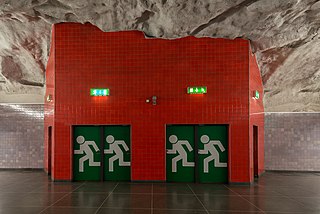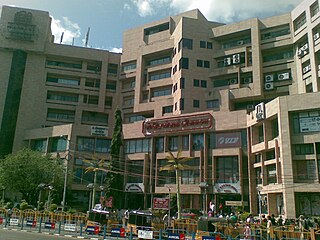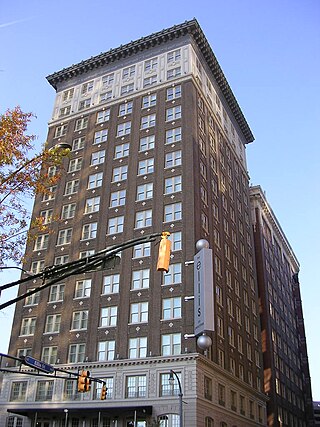
A fire sprinkler system is an active fire protection method, consisting of a water supply system, providing adequate pressure and flowrate to a water distribution piping system, onto which fire sprinklers are connected. Although historically only used in factories and large commercial buildings, systems for homes and small buildings are now available at a cost-effective price. Fire sprinkler systems are extensively used worldwide, with over 40 million sprinkler heads fitted each year. Even though fire sprinkler systems are a life saving system and are not designed to protect the building, 96% of buildings that had fires and were completely protected by fire sprinkler systems were controlled by the fire sprinklers alone.

Stairs are a structure designed to bridge a large vertical distance between lower and higher levels by dividing it into smaller vertical distances. This is achieved as a diagonal series of horizontal platforms called steps which enable passage to the other level by stepping from one to another step in turn. Steps are very typically rectangular. Stairs may be straight, round, or may consist of two or more straight pieces connected at angles.

The MGM Grand fire occurred on Friday, November 21, 1980 at the MGM Grand Hotel and Casino, located on the Las Vegas Strip in Paradise, Nevada. The fire killed 85 people, most through smoke inhalation. The fire began from a refrigerated pastry display case in one of the restaurants, located on the first floor. Fire engulfed the resort's casino, and smoke travelled into the hotel tower.

On Monday, December 1, 1958, a fire broke out at Our Lady of the Angels School in Chicago, Illinois, shortly before classes were to be dismissed for the day. The fire originated in the basement near the foot of a stairway. The elementary school was operated by the Archdiocese of Chicago and had an enrollment of approximately 1600 students. A total of 92 pupils and 3 nuns ultimately died when smoke, heat, fire, and toxic gases cut off their normal means of egress through corridors and stairways. Many more were injured when they jumped from second-floor windows which, because the building had a raised basement, were nearly as high as a third floor would be on level ground.

The Iroquois Theatre fire occurred on December 30, 1903, at the Iroquois Theatre in Chicago. It is one of the deadliest single-building fires in U.S. history, resulting in 602 deaths.

An emergency exit in a structure is a special exit for emergencies such as a fire: the combined use of regular and special exits allows for faster evacuation, while it also provides an alternative if the route to the regular exit is blocked.
The publication Life Safety Code, known as NFPA 101, is a consensus standard widely adopted in the United States. It is administered, trademarked, copyrighted, and published by the National Fire Protection Association and, like many NFPA documents, is systematically revised on a three-year cycle.

A fire escape is a special kind of emergency exit, usually mounted to the outside of a building or occasionally inside but separate from the main areas of the building. It provides a method of escape in the event of a fire or other emergency that makes the stairwells inside a building inaccessible. Fire escapes are most often found on multiple-story residential buildings, such as apartment buildings. At one time, they were a very important aspect of fire safety for all new construction in urban areas; more recently, however, they have fallen out of common use. This is due to the improved building codes incorporating fire detectors, technologically advanced fire fighting equipment, which includes better communications and the reach of fire fighting ladder trucks, and more importantly fire sprinklers. The international building codes and other authoritative agencies have incorporated fire sprinklers into multi-story buildings below 15 stories and not just skyscrapers.

Spencer Plaza is a shopping mall located on Anna Salai in Chennai, Tamil Nadu, India, and is one of the modern landmarks of the city. Originally built during the period of the British Raj and reconstructed in 1985 on the site of the original Spencer's department store, it is the oldest shopping mall in India and was one of the biggest shopping malls in South Asia when it was built. It is one of the earliest Grade A commercial projects of the city, which were developed in the second half of the 1990s. As of March 2010, it is the 11th largest mall in the country, with a gross leasable (retail) area of 530,000 sq ft.
A placard is a notice installed in a public place, like a small card, sign, or plaque. It can be attached to or hung from a vehicle or building to indicate information about the vehicle operator or contents of a vehicle or building. It can also refer to paperboard signs or notice carried by picketers or demonstrators.

"Common lodging-house" is a Victorian era term for a form of cheap accommodation in which inhabitants are lodged together in one or more rooms in common with the rest of the lodgers, who are not members of one family, whether for eating or sleeping. The slang terms dosshouse and flophouse designate roughly the equivalent of common lodging-houses. The nearest modern equivalent is a hostel.

Fire protection is the study and practice of mitigating the unwanted effects of potentially destructive fires. It involves the study of the behaviour, compartmentalisation, suppression and investigation of fire and its related emergencies, as well as the research and development, production, testing and application of mitigating systems. In structures, be they land-based, offshore or even ships, the owners and operators are responsible to maintain their facilities in accordance with a design-basis that is rooted in laws, including the local building code and fire code, which are enforced by the authority having jurisdiction.

The Brown Building is a ten-story building that is part of the campus of New York University (NYU), which owns it. It is located at 23–29 Washington Place, between Greene Street and Washington Square East in the Greenwich Village neighborhood of Manhattan, New York City, and is best known as the location of the March 25, 1911, Triangle Shirtwaist Factory fire, which killed 146 people.

The 1913 Binghamton factory fire occurred on July 22, 1913, on the premises of the Binghamton Clothing Company, in Binghamton, New York. It destroyed the Wall Street building in less than 20 minutes, killing 31 of the more than 100 people inside. Though not as deadly as the Triangle Shirtwaist Factory fire in 1911, it put even more pressure on New York officials to strengthen life safety codes, increase funding for more inspectors, and increase penalties for violations.
Home safety is the awareness of risks and potential dangers in and around a home which may cause bodily harm, injury, or even death to those living there.

The Winecoff Hotel fire of December 7, 1946, was the deadliest hotel fire in American history, killing 119 hotel occupants, including the hotel's original owners. Located at 176 Peachtree Street in Atlanta, Georgia, the Winecoff Hotel was advertised as "absolutely fireproof". While the hotel's steel structure was indeed protected against the effects of fire, its interior finishes were combustible and the building's exit arrangements consisted of a single stairway serving all fifteen floors. All of the hotel's occupants above the fire's origin on the third floor were trapped, and the fire's survivors either were rescued from upper-story windows or jumped into nets held by firemen.

The Royal Jomtien Resort Hotel was a 450-room luxury hotel situated in a 17-story high-rise building on the northern end of Jomtien Beach, 110 kilometres (68 mi) south of Bangkok. At approximately 10:20 local time, 11 July 1997, a fire ignited as a result of a faulty liquid propane gas cylinder in a ground floor buffet of the hotel. The fire burned for 8 to 12 hours across all floors and caused the deaths of at least 91 people and injuries to a further 63.
On the night of December 28, 2017, a fire tore through an apartment building in the Belmont neighborhood of the Bronx in New York City. Thirteen people died, and fourteen others were injured. At the time, it was the city's deadliest fire in 25 years, being surpassed a little over four years later by another apartment fire in the Bronx that killed seventeen people.
The Beverly rooming house fire took place at the Elliott Chambers, a low-rent rooming house in Beverly, Massachusetts, on July 4, 1984. The fire was set by a man whose ex-girlfriend was going out with someone who was staying in the building. It was the deadliest arson fire in Massachusetts, the deadliest fire in the state since the Cocoanut Grove fire in 1942, and the deadliest fire in Beverly's history.















